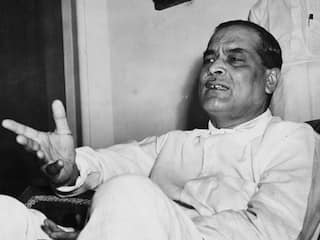Dr. Bidhan Chandra Roy was an influential Indian doctor and politician who was born on July 1, 1882, in Patna, India. Dr. Roy became the second Chief Minister of West Bengal, serving from 1948 until he died in 1962.
He played a crucial role in state development. Under his leadership, Western Bengal became one of the main regions of the Indian subcontinent. Dr. Roy was also a respected medical professional, known for his health contributions.
He was awarded the Bharat Ratna, India's highest civilian honour, in 1961 for his exceptional service. His legacy is celebrated annually on National Doctors' Day, observed on his birth and death anniversary.
Check Out| National Doctor's Day 2025: Theme, History, and Facts You Need To Know
Who was Dr Bidhan Chandra Roy?

Source: ABP
Dr. Bidhan Chandra Roy, born July 1, 1882, in Patna, was a prominent doctor and politician in India. He pursued his education at Presidency College, Calcutta, and achieved his medical degree from the University of Calcutta.
He served as the second chief minister in West Bengal from 1948 until he stepped down in 1962, and made significant advances in the health care, education and infrastructure development.
Career
Dr. Bidhan Chandra Roy made significant contributions to medical education by founding the Indian Medical Association and the Medical Council of India, serving as its first president.
As a politician, he focused on healthcare reforms, infrastructure development, and education, leaving a lasting impact as the second Chief Minister of West Bengal.
1. Early Career and Education
- Joined the Provincial Health Service upon returning to India.
- Engaged in private practice and served as a nurse when needed.
- Taught at Medical College and Hospital, Kolkata; Campbell Medical School; and Carmichael Medical College.
- First president of the Cardiological Society of India (1948-1950).
2. Health and Education Advocacy
- Advocated for swaraj, emphasising the importance of health for freedom.
- Contributed to the establishment of several medical institutions:
- Jadavpur T.B. Hospital
- Chittaranjan Seva Sadan
- Kamala Nehru Memorial Hospital
- Victoria Institution
- Chittaranjan Cancer Hospital
- Opened the Chittaranjan Seva Sadan for women and children in 1926.
3. Political Involvement
- Ran as an independent candidate in 1925, defeating Surendranath Banerjee.
- Voted with the Swaraj Party despite being an independent.
- Proposed a resolution in 1925 to study and address pollution in the Hooghly.
- Elected to the All India Congress Committee in 1928.
- Led Civil Disobedience in Bengal in 1929 and became a member of the Congress Working Committee in 1930.
- Arrested during the CWC's unlawful assembly in August 1930.
4. Leadership in Local Government
- Served as Alderman (1930-1931) and Mayor of Calcutta (1931-1933).
- Expanded initiatives for free education, medical aid, improved infrastructure, and water supply.
- Established a framework for grants to hospitals and charitable dispensaries.
5. Response to Crisis
- In 1942, during the Japanese bombing of Rangoon, they facilitated air-raid shelters for students.
- Provided relief for students, teachers, and employees while serving as Vice-Chancellor of the University of Calcutta.
Honours & Awards
In recognition of his remarkagacyble contributions, he was awarded with Bharat Ratna, India's highest civilian honour, in 1961. His le is remembered every year on National Doctors' day, which coincides with his birth and day of death.
Read On| Who Was India's First Woman Doctor?
Conclusion
Dr. Bidhan Chandra Roy was an extraordinary person in Indian history, serving simultaneously as a physician and a politician. Roy was born on 1 July 1882 in Patna, Bihar. Dr Roy served as the second Chief Minister of West Bengal from 1948 until his passing on July 1, 1962.
His tenure was really a whirlwind of remarkable progress in healthcare, education and infrastructure. He was instrumental in rehabilitating refugees after the Partition and promoting industrial development in the state.
His vision and dedication to public health and education are largely responsible for establishing public medicine as the bedrock of modern Indian medical practice. His contributions earned him the Bharat Ratna, India's largest civil prize, in 1961.
Today, he is remembered not only for his political achievements, but as a giant in the medical profession, as National Doctors Day is celebrated in his honour each year on his birthday of birth and death.
Comments
All Comments (0)
Join the conversation